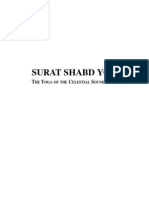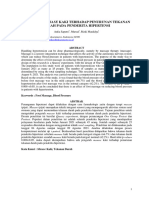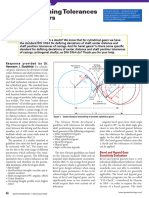An Extant Sculpture of Bhairava'
An Extant Sculpture of Bhairava'
Uploaded by
singingdrumCopyright:
Available Formats
An Extant Sculpture of Bhairava'
An Extant Sculpture of Bhairava'
Uploaded by
singingdrumOriginal Description:
Original Title
Copyright
Available Formats
Share this document
Did you find this document useful?
Is this content inappropriate?
Copyright:
Available Formats
An Extant Sculpture of Bhairava'
An Extant Sculpture of Bhairava'
Uploaded by
singingdrumCopyright:
Available Formats
OHRJ, Vol. XLVII, No.
AN EXTANT SCULPTURE OF BHAIRAVA AT PATANAGARH
Dr. Jadumani Mahapatra
Patanagarh is a subdivisional headquarters, situated 38 kms. west of the district headquarters of Bolangir in Orissa. The piece of sculpture, which is the subject matter of this paper, has been housed in a cement-brick shrine built recently for it on the confluence of two rivuletsMayavati and Swarnarekha that flow down for a few kilometers and meet in the river Suktel.The delta created by these rivulets has the ruins of a fortified township ascribable to a period between the eleventh and eighteenth centuries of the Christian era. Apart from these ruins, remains of potteries,beads of semi-precious stones,ring stones etc., are noticed on both the banks of the Mayavati. These antiquities could be ascribed to a much earlier date than the remnants of the fortified township.The stone panel on which the sculpture of Bhairava has been carved out was previously lying in a corn field receiving only occasional attention of devotees1 . The sculpture of Bhairava has been carved out in high relief on a piece of fine grained sandstone of 73 cms. length (height) and 50cms. breadth. Bhairava having eight hands has been depicted as dancing on a pretasana. In the major right arm he holds a sword .In other right arms, from top to bottom, the attributes are a trident with a short grip, mushala and a kartri (dagger). In the major left hand he holds a khetaka (shield). The attributes in other left hands are fire in a bow, ankusha and a naga (serpent noose) respectively. The other conspicuous features are jata mukuta tied with a string of beads, and patra kundala on both the ear-lobes2. Two flames are surging upward on both sides of the head. The other ornaments are beaded wrist-lets, armlets and anklets etc. The yajnopavita is clearly discernible. The stumpv nose, fleshy lips, round widely opened eyes, all add to the furious look of the sculpture. A short dhoti wrapped up with a skirt (skin of the elephant gajasura) has served the purpose of the lower garment. The folds of the dhoti have hung down between the widely opened legs. On both the flanks below are seven anthropomorphic depictions - five on the right and two on the left. All are female figures. These female figures possibly represent the seven mothers. They have karanda mukuta on their heads3. Other ornaments and dresses are not clearly discernible. Conforming to the iconography each of the female figures has two hands4. It seems that the idea of carving out the matrika icons along with Bhairava is an after-thought of the sculptor. Hence he has used the surplus space of the stone panel that
54
OHRJ, Vol. XLVII, No. 1
remained after the icon of Bhairava was carved out. As the space is inadequate the matrka images have been small and clumsy in their depiction. Bhairava is a manifestation of Shiva worshipped by the kapalikas as their chief god. They hold Him responsible for the creation, protection and destruction of the universe. They believe that all the gods are subservient to Him5. From iconographical stand point Bhairava is a medieval image type of Shiva representing his ugra form6. This image type can be classified under samharamurti group and Vatuka Bhairava sub-group of shaiva iconography. The multiple number of hands of Bhairava testifies to its tamasika character and Bhairava in this form is associated with the tandava of Shiva for cosmic absorption and regeneration. The Pingala Nighantu mentions Vatukabhairava as kshetrapala or the guardian deity of the place of its installation7. The Shiva Purana describes Bhairava as the purnarupa of Shankara.8 The cult of Bhairava worship bears testimony to the fact that Pashupata shaivism was very popular in this region then known as Dakshina Koshala. This icon of Bhairava was sculptured out and, a shrine for him and his divine consorts, the Seven Mothers, was erected at the place under the influence of the Kapalikas - a sub-sect of the Pashupata School of Shaivism. This has been substantiated by a number of sculptural depiction of Shiva and shaivacharyas of Pashupata sect on the antique pillars of the Somcshvara (Koshalesvara) temple standing not far away from the site where the present Bhairava icon was discovered9. The piece of sculpture under discussion can be assigned to the early twelfth century A.D. or a little later, after the Someshvara temple was erected. Possibly, Bhairava had been installed in the north-east corner of the fortified township as the guardian deity of the locality. Later on under the influence of the Sahajia philosophy of the Buddhist Sahaja Yana and shaivite Natha cult, which emphasized on the Pinda-Brahmanda theory, the shrine of Bhairava became the center of tantric sadhana.10 By sixteenth century AD Patanagarh, the headquarters of the Patana Dandapata had attained celebrity as kumari Patana, the famous seat of tantra sadhana.11
REFERENCES:
1. SP Khuntia, Senior Lecturer in the department of History, Jawaharlal College, Patanagarh has collected some antiquities from the site where the sculpture of Bhairava was lying uncared-for and also by exploring both the banks of the rivulet Mayavati. The local people worship the icon as Bhainro. A non-Brahmin priest designated us dehelia looks after the daily rituals of the deity. 2. T. A. Gopinath Rao, Elements of Hindu Iconography, 2nd ed., I (1), Delhi, 1997, pl. IV, fig. 15 (facing page 11). 3. Ibid. p4. VIII , fig.2 (facing page 29). 4. lbid. p.13. 5. Ibid., II (1), p2; K. C. Panigrahi, Archaeological Remains at Bhubaneswar, 2nd ed., Cuttack, 1981, p. 234.
55
OHRJ, Vol. XLVII, No. 1
6. T. M. P. Mahadevan, Saivism, in R.C. Majumdar (ed), The History and Culture of the Indian People: The Age of Imperial Kanauj. 2nd ed., IV, Vidyabhavan, Bombay, 1964, p. 305. 7. T. A. G. Rao, op. Cit., II (2), p. 498. 8. K.C.Panigrahi,op.cit.,p.80;T.A.G.Rao.,II(1),p. 176. 9. Lakulisha sitting in cross- legged position with the yogapatta tied around, enigmatic figures in yogic postures have been carved out in low relief on the pillars of an extinct Shiva temple now supporting the entrance hall of the Someshvara temple renovated sometime in the 19th century AD. The brick and stone shrine dedicated to Bhairava and the seven mothers was in ruins. Now the site has been totally disturbed by local brick makers. A few years back, S. P. Khuntia had recovered from this site, a full size brick measuring 37cms. in length, 27cms. in breadth and 10 cms. in thickness. This type of brick was used in this region in the early medieval period. Only one matrka icon in sitting posture, in a badly damaged condition, has been recovered from the old site and placed in the outer niche of the Bhainro gudi. 10. K. C. Mishra, Odishi Vaihnava Dharma (Oriya) 3rd ed., Bhubaneswar, 1990, p. ga of the editorial note by Raicharan Das ; B. Pradhan, Minor Religious Sects of Orissa, in S. Pradhan (ed), Orissan History, Culture and Archaeology. 1st ed ., New Delhi, 1999, p. 164. 11 N. K. Sahu, Ch. II, History, in N. Senapati et.al. (ed). Gazetteers of India: Orissa District Gazetteers : Balangir, 1st ed., Cuttack, 1968, p.489. Senior Lecturer Jawaharlal College, Patanagarh Balangir767025. E.Mail:jmph@sancharnet.in
An extant sculpture of Bhairava at Patanagarh
56
You might also like
- God As Divine MotherDocument86 pagesGod As Divine MotherDakini Goddess100% (1)
- 2017-NIFSAB SprinklerInspection PocketGuide-WebDocument16 pages2017-NIFSAB SprinklerInspection PocketGuide-WebManav GaneshNo ratings yet
- POWER AGE (Updated.1)Document140 pagesPOWER AGE (Updated.1)Chris Agan86% (7)
- Sample Letter of Direct Request PlanDocument8 pagesSample Letter of Direct Request PlanKhawaja Haseeb Ur Rehman100% (7)
- Art of Mauurya Period: Pillars, Sculptures and Rock-Cut ArchitectureDocument3 pagesArt of Mauurya Period: Pillars, Sculptures and Rock-Cut ArchitecturemirzaNo ratings yet
- ch3 PDFDocument8 pagesch3 PDFjayant5253No ratings yet
- Hindu Civilization in Binjor and in Laos Attested by A Āśri Yū PDFDocument15 pagesHindu Civilization in Binjor and in Laos Attested by A Āśri Yū PDFgrdprashant974No ratings yet
- Arts of The Mauryan Period Indian Culture Series NCERTDocument6 pagesArts of The Mauryan Period Indian Culture Series NCERTDHUVADU JAGANATHAMNo ratings yet
- Arts of The Mauryan PeriodDocument6 pagesArts of The Mauryan PeriodNimisha SwarupNo ratings yet
- RTS OF THE Auryan Eriod: ShramanDocument8 pagesRTS OF THE Auryan Eriod: ShramanDevika Makand RajputNo ratings yet
- Prabhavali Fragment PDFDocument6 pagesPrabhavali Fragment PDFdevjain.progamer.365No ratings yet
- Art and Culture Notes PDFDocument54 pagesArt and Culture Notes PDFmanuj100% (1)
- Indian Architecture and Art Forms MANUJ JINDAL AIR 53Document38 pagesIndian Architecture and Art Forms MANUJ JINDAL AIR 53MDMahmoodulHassanNo ratings yet
- Hindu CambodiaDocument186 pagesHindu Cambodianishah.020289No ratings yet
- Antiquity of Shri JagannathDocument9 pagesAntiquity of Shri JagannathGeetha RamanathanNo ratings yet
- Important Caves (History, Art & Culture)Document6 pagesImportant Caves (History, Art & Culture)DAR BILALNo ratings yet
- Indian Art (R)Document13 pagesIndian Art (R)Sambit MishraNo ratings yet
- Introduction To Indian Art - Class 11-3Document15 pagesIntroduction To Indian Art - Class 11-3jacksparrow68977No ratings yet
- Complete Ancient History Capsule For SSC DP SSC GD 2024Document9 pagesComplete Ancient History Capsule For SSC DP SSC GD 2024ponnamnagaraj999No ratings yet
- Loni Bhapkar TemplesDocument18 pagesLoni Bhapkar TemplesDarshan ShindeNo ratings yet
- Bhandarkar Oriental Research InstituteDocument7 pagesBhandarkar Oriental Research InstituteAigo Seiga CastroNo ratings yet
- Jaina Sculpture in Orissa State MuseumDocument4 pagesJaina Sculpture in Orissa State MuseumHemant JainNo ratings yet
- 14000-Art-and-Culture-Ch-1Document5 pages14000-Art-and-Culture-Ch-1Priyanka PaulNo ratings yet
- Iconography - of - Avalokitesvara - Book ReviewDocument3 pagesIconography - of - Avalokitesvara - Book ReviewМастерЙодаNo ratings yet
- Tracing The Growth of Shaivaism in JammuDocument3 pagesTracing The Growth of Shaivaism in JammuEditor IJTSRDNo ratings yet
- Emergence of Saivism in Andhra Dr. D. Kiran Kranth ChoudaryDocument18 pagesEmergence of Saivism in Andhra Dr. D. Kiran Kranth Choudarykkkotha2366No ratings yet
- SculptureDocument11 pagesSculpturetishabhatt55No ratings yet
- Rksamiia-The Bear-Faced Khajuriiho: YoginiDocument9 pagesRksamiia-The Bear-Faced Khajuriiho: YoginiankitNo ratings yet
- Post Mauryan Art and ArchitectureDocument5 pagesPost Mauryan Art and ArchitectureAvantika YadavNo ratings yet
- MauryanDocument5 pagesMauryanAyushNo ratings yet
- Art CultutreDocument33 pagesArt CultutreSona SunilNo ratings yet
- 3MauryanArt Part2Document17 pages3MauryanArt Part2Megha LokeshNo ratings yet
- World Antiquarianism Comparative Perspectives (Alan Schnapp, (Editor) ) (Z-Library) - 432-447Document18 pagesWorld Antiquarianism Comparative Perspectives (Alan Schnapp, (Editor) ) (Z-Library) - 432-447padmakshi.singhug2023No ratings yet
- Amity University: Amity School of Fine ArtsDocument13 pagesAmity University: Amity School of Fine ArtsAnjali SinghalNo ratings yet
- Iconography in Kerala Tantric PDFDocument26 pagesIconography in Kerala Tantric PDFJpsworldNo ratings yet
- Glossary (Buddhism, Buddhist Art Archaeology)Document6 pagesGlossary (Buddhism, Buddhist Art Archaeology)Chan DanielNo ratings yet
- MauryansDocument3 pagesMauryansUdit MuthaNo ratings yet
- Minor Cults Saktism Buddhism Surya Cult PDFDocument32 pagesMinor Cults Saktism Buddhism Surya Cult PDFBiswajit SatpathyNo ratings yet
- Minor Cults Saktism Buddhism Surya Cult PDFDocument32 pagesMinor Cults Saktism Buddhism Surya Cult PDFBiswajit SatpathyNo ratings yet
- Minor Cults Saktism Buddhism Surya Cult PDFDocument32 pagesMinor Cults Saktism Buddhism Surya Cult PDFBiswajit SatpathyNo ratings yet
- Minor Cults Saktism Buddhism Surya Cult PDFDocument32 pagesMinor Cults Saktism Buddhism Surya Cult PDFBiswajit SatpathyNo ratings yet
- Minor Cults Saktism Buddhism Surya Cult PDFDocument32 pagesMinor Cults Saktism Buddhism Surya Cult PDFBiswajit SatpathyNo ratings yet
- KanganhalliDocument6 pagesKanganhalliGradin JoseNo ratings yet
- Antiquities of Shri JagannathDocument7 pagesAntiquities of Shri JagannathChristian CiccoNo ratings yet
- 2nd Part, Art and Culture Series PDFDocument213 pages2nd Part, Art and Culture Series PDFBhagwandas GaikwadNo ratings yet
- Content: Mauryan Period 4 Post Mauryan 5 Gupta Period 6 Post Gupta Period 7 Delhi Sultanate 9 Mughal Period 10Document9 pagesContent: Mauryan Period 4 Post Mauryan 5 Gupta Period 6 Post Gupta Period 7 Delhi Sultanate 9 Mughal Period 10rahu69No ratings yet
- NrusinghanathaDocument3 pagesNrusinghanathaSurendra Hota100% (1)
- Orissa Review-Saktism at BhubaneswarDocument5 pagesOrissa Review-Saktism at BhubaneswarpervincarumNo ratings yet
- Shunga ArtDocument13 pagesShunga ArtAmeera Sara Thomas100% (1)
- Ancient Indian Sculpture, C. 300 - 700 CE PDFDocument28 pagesAncient Indian Sculpture, C. 300 - 700 CE PDFAnuj MeenaNo ratings yet
- Samlie TempleDocument7 pagesSamlie TempleS.s. MichaelNo ratings yet
- Yoni Temples and Those of IndonesiaDocument14 pagesYoni Temples and Those of IndonesiaUday DokrasNo ratings yet
- Bolangir Chapter 2Document59 pagesBolangir Chapter 2KUMBHIPADA SCHOOLNo ratings yet
- SculpturesDocument4 pagesSculptureskanak karihalooNo ratings yet
- Maurya Art and Sunga ArtDocument5 pagesMaurya Art and Sunga Arts.acharya100% (1)
- Sannati 1Document2 pagesSannati 1nasundara9258No ratings yet
- Stupa ArchitectureDocument8 pagesStupa Architectureramish mushfiqNo ratings yet
- Post Mauryan Trends in Indian Art and Architecture 2.compressedDocument15 pagesPost Mauryan Trends in Indian Art and Architecture 2.compressedvpNo ratings yet
- Krishan EroticSculpturesIndia 1972Document14 pagesKrishan EroticSculpturesIndia 1972kash.ewhNo ratings yet
- Class 11 Unit 2 Part ADocument4 pagesClass 11 Unit 2 Part Akingofking10293847No ratings yet
- The Representation of Women in The Erotic Sculptures of KhajurahoDocument25 pagesThe Representation of Women in The Erotic Sculptures of KhajurahoAjay Parmar100% (2)
- Colossal Buddha Images of Ancient Sri LankaDocument3 pagesColossal Buddha Images of Ancient Sri Lankashu_sNo ratings yet
- Yoni BookDocument189 pagesYoni BookUday DokrasNo ratings yet
- Guru Nanak JayadevaDocument3 pagesGuru Nanak JayadevasingingdrumNo ratings yet
- Prabandha Vol51 - 2016 - 1 - Art17 PDFDocument13 pagesPrabandha Vol51 - 2016 - 1 - Art17 PDFsingingdrumNo ratings yet
- Bhakti Ratnakara Fifth - WaveDocument83 pagesBhakti Ratnakara Fifth - WavesingingdrumNo ratings yet
- Dance of The MonksDocument10 pagesDance of The MonkssingingdrumNo ratings yet
- Early Indian Iconography CoomaraswamyDocument27 pagesEarly Indian Iconography CoomaraswamysingingdrumNo ratings yet
- The Interplay Between Marriage, Ritual, and Art in MithilaDocument15 pagesThe Interplay Between Marriage, Ritual, and Art in MithilasingingdrumNo ratings yet
- Introducing VyangyaVyakhyaDocument3 pagesIntroducing VyangyaVyakhyasingingdrumNo ratings yet
- The Bon Zhuang ZhungDocument13 pagesThe Bon Zhuang ZhungsingingdrumNo ratings yet
- The Ratha Yatra of Shri JagannathDocument3 pagesThe Ratha Yatra of Shri JagannathsingingdrumNo ratings yet
- Kal Am PattuDocument4 pagesKal Am PattusingingdrumNo ratings yet
- Writing and Performing The Trinity of OdissiDocument11 pagesWriting and Performing The Trinity of Odissisingingdrum100% (1)
- Elegiac Chhand and Duha in Charani LoreDocument18 pagesElegiac Chhand and Duha in Charani LoresingingdrumNo ratings yet
- On The Dohada, or Craving of The Pregnant Woman, As A Motif in Hindu FictionDocument8 pagesOn The Dohada, or Craving of The Pregnant Woman, As A Motif in Hindu FictionsingingdrumNo ratings yet
- Women, Abuse Songs and Erotic Dances Marriage Ceremonies in Northern IndiaDocument13 pagesWomen, Abuse Songs and Erotic Dances Marriage Ceremonies in Northern IndiasingingdrumNo ratings yet
- From Music To PaintingsDocument9 pagesFrom Music To PaintingssingingdrumNo ratings yet
- Chandogya UpanishadDocument529 pagesChandogya Upanishadtechy82100% (12)
- Madhava, Nilamadhava and Shree JagannathDocument3 pagesMadhava, Nilamadhava and Shree JagannathsingingdrumNo ratings yet
- Naam or Word (Sant Kirpal Singh)Document339 pagesNaam or Word (Sant Kirpal Singh)Lobuscher100% (7)
- Introduction To The PancaratraDocument9 pagesIntroduction To The PancaratrasingingdrumNo ratings yet
- Headless Goddess of Nuapada OrissaDocument12 pagesHeadless Goddess of Nuapada OrissasingingdrumNo ratings yet
- Wasifuddin Dagar InterviewDocument7 pagesWasifuddin Dagar InterviewsingingdrumNo ratings yet
- Surat Shabd Yoga, The Yoga of The Celestial Sound CurrentDocument94 pagesSurat Shabd Yoga, The Yoga of The Celestial Sound CurrentSant Mat80% (5)
- Orissa Review June 2006Document167 pagesOrissa Review June 2006singingdrumNo ratings yet
- Orissa Review December 2005Document85 pagesOrissa Review December 2005singingdrumNo ratings yet
- New Light On Saint Poet Sri Jayadev and GitagovindaDocument20 pagesNew Light On Saint Poet Sri Jayadev and Gitagovindasingingdrum100% (1)
- May 2016 - International PDFDocument104 pagesMay 2016 - International PDFBánh Cuốn Tôm ThịtNo ratings yet
- To Make A Nature Poem IIIDocument5 pagesTo Make A Nature Poem IIITom MNo ratings yet
- GEMINI II Operating Instructions 06-235975-001 Print 5127 2014-05-08Document120 pagesGEMINI II Operating Instructions 06-235975-001 Print 5127 2014-05-08Nattapong Natt100% (1)
- Pengaruh Masase Kaki Terhadap Penurunan Tekanan Darah Pada Penderita HipertensiDocument9 pagesPengaruh Masase Kaki Terhadap Penurunan Tekanan Darah Pada Penderita HipertensiBelva EdinaNo ratings yet
- 1.DHF 00 A P 003 R1 Vendor Data InstructionDocument29 pages1.DHF 00 A P 003 R1 Vendor Data Instructionnghiep congNo ratings yet
- Settle OutDocument6 pagesSettle Outamitgoel1989100% (1)
- Alfa Laval System DescriptionDocument18 pagesAlfa Laval System DescriptionAndré HeunisNo ratings yet
- Lecture 1 Productivity MeasurementDocument15 pagesLecture 1 Productivity MeasurementIbrar ShahNo ratings yet
- Cohen 2012 - Telemorphosis Theory in The Era of Climate Change Vol 1Document314 pagesCohen 2012 - Telemorphosis Theory in The Era of Climate Change Vol 1mplateau100% (1)
- Distinction in PhysicsDocument109 pagesDistinction in PhysicsjudithchilyatakachakwaleNo ratings yet
- Plant Anatomy and PhysiologyDocument55 pagesPlant Anatomy and PhysiologyGEORGIA NAHAK100% (1)
- Development of A Mobile Application For Monitoring and Controlling A CNC Machine Using Industry 4.0 ConceptsDocument8 pagesDevelopment of A Mobile Application For Monitoring and Controlling A CNC Machine Using Industry 4.0 ConceptsVõ Hoàng KhôiNo ratings yet
- Airport InformationDocument12 pagesAirport InformationSeyi WilliamsNo ratings yet
- Cambridge International General Certificate of Secondary EducationDocument16 pagesCambridge International General Certificate of Secondary Educationhrenad763No ratings yet
- Snapple Case StudyDocument15 pagesSnapple Case StudySandy NguyenNo ratings yet
- Oster 3157 Manual de UsuarioDocument52 pagesOster 3157 Manual de UsuarioCarla Mishell Perez RamosNo ratings yet
- Lijadora Banda-Disco Craftsman 137.215280Document10 pagesLijadora Banda-Disco Craftsman 137.215280Pakito XtradaNo ratings yet
- FTTH Case StudyDocument19 pagesFTTH Case Studyhatiim2000No ratings yet
- Shoulder DislocationDocument6 pagesShoulder DislocationRizki IrwansyahNo ratings yet
- Amd2a40+50 Panel Manual 2024-Jun-01Document78 pagesAmd2a40+50 Panel Manual 2024-Jun-01Karito DiegoNo ratings yet
- Decision Science - MCQDocument36 pagesDecision Science - MCQpritesh0% (1)
- Wire LineDocument9 pagesWire LineAchmad Arief SolichinNo ratings yet
- Manoj Seminar1 PDFDocument30 pagesManoj Seminar1 PDFnagaraju jujuriNo ratings yet
- Geography Grade 6 Unit 1Document8 pagesGeography Grade 6 Unit 1Rmk JayathilakaNo ratings yet
- Bevel ShaftsDocument6 pagesBevel ShaftsdubiouslineageNo ratings yet
- Search Exercises AIMA ExercisesDocument12 pagesSearch Exercises AIMA Exercisesrafeak rafeakNo ratings yet
- Budge Budge VT ReportDocument51 pagesBudge Budge VT ReportSayak Kumar DuttaNo ratings yet



















































































































